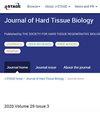性别和年龄在下颌分支和身体测量上的差异:一项放射学研究
IF 0.4
4区 医学
Q4 ENGINEERING, BIOMEDICAL
引用次数: 3
摘要
方法:对140例5 ~ 24岁的患者进行口腔全景x线片(PR)和侧位头颅x线片(LC)检查,探讨下颌形态与性别、年龄的关系。这些影片被分为七个年龄段。记录、测量下颌双侧宽度(BW)、下颌体高(MBH)和长度(MBL)、下颌支宽(MRW)、高度(MRH)和长度(MRL)、下颌角。显著性水平设为0.05。在我们的研究中,BW和MRW的平均值在17岁之前随着年龄的增加而增加,然后开始下降。男女患者前后路MBH和MBL均随年龄增加而增加,其中前路MBH 1组与2组、4组与5组间差异有统计学意义(p < 0.05),后路MBH和MBL 3组与4组间差异有统计学意义(p < 0.05)。MRH和MRL也随着年龄的增长而升高,MRH的第三、四、五年龄组与MRL的第四、五、五年龄组(p < 0.05)、MRL的第四、五、五年龄组(p < 0.05)之间的差异有统计学意义。另一方面,随着年龄的增长,棱角逐渐减小,但差异不显著。下颌生长知识是骨科诊断和治疗计划的重要因素,也是社区医学监测儿童生长的重要因素。本文章由计算机程序翻译,如有差异,请以英文原文为准。
Gender and Age Differences in Mandibular Ramus and Body Measurements: A Radiographic Study
: The dental panoramic radiographs (PR) and lateral cephalographs (LC) of 140 subjects in the age group between 5 and 24 years were examined to evaluate the mandibular morphology in relation to gender and age. The examined films were divided into seven age groups. The bigonial width (BW), mandibular body height (MBH) and length (MBL), mandibular ramus width (MRW), height (MRH) and length (MRL), and gonial angle were recorded, measured and the data analyz-ed. Level of significance was set at 0.05. In our study the mean value of BW and MRW increased in both gender with in creasing age up to age 17 years, then began decreasing. The anterior and posterior MBH and MBL increased with increasing age for both genders with statistically significant differences between the first and second groups ( p < 0.05) and the fourth and fifth groups ( p < 0.05) for anterior MBH, and between the third and fourth groups ( p < 0.05) for posterior MBH and MBL ( p < 0.05). MRH and MRL also increased with increasing age with statistically significant differences between the third and fourth ( p < 0.05) and the fourth and fifth ( p < 0.05) age groups for MRH and the fourth and fifth ( p < 0.05) and fifth and sixth ( p < 0.05) age groups for MRL. On the other hand, the gonial angle decreased with increasing age but without significant differences. Knowledge of mandibular growth is important factors for diagnosis and treatment planning in ortho dontics as well as community medicine for monitoring the growth of children.
求助全文
通过发布文献求助,成功后即可免费获取论文全文。
去求助
来源期刊

Journal of Hard Tissue Biology
ENGINEERING, BIOMEDICAL-
CiteScore
0.90
自引率
0.00%
发文量
28
审稿时长
6-12 weeks
期刊介绍:
Information not localized
 求助内容:
求助内容: 应助结果提醒方式:
应助结果提醒方式:


